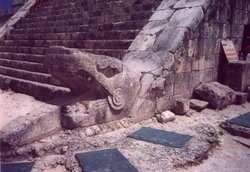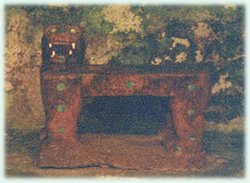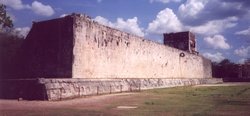Chichen Itza
|
|
Templo_de_los_Guerreros-x768.jpg
Chichen Itza is the largest of the Pre-Columbian archaeological sites in Yucatán, Mexico. The city was built by the Maya civilization.
| Contents |
The name
The name is often represented as Chichén Itzá in Spanish and other languages to show that both parts of the name are stressed on their final syllables. In the Yucatec Maya language (still in use in the area, and written with the Roman alphabet since the 16th century) this stress follows the rules of the language so it is written without diacritics. The Maya name "Chichen Itza" means "At the mouth of the wells of the Itza people". Although this was the usual name for the site in Pre-Columbian times, it is also referred to in the ancient chronicles as Uucyabnal, meaning "Seven Great Rulers".
The site
El_Caracol_observatory-x768.jpg
El_Castillo_at_Chichén_Itzá_Mexico.jpg
Lightmatter_chichen15.jpg
Sacred-cenote.jpg
"Chichen" contains many fine stone buildings in various states of preservation; the buildings were formerly used as temples, palaces, stages, markets, baths, and ballcourts.
The Yucatán has no above-ground rivers, so the fact that there were three natural sink holes (cenotes) providing plentiful water year round at Chichen made it a natural spot for a center of population. Two of these cenotes are still in existence, the most famous being the legendary "Cenote of Sacrifice", which was sacred to the Maya rain god Chac. Offerings of jade, pottery, and incense were thrown into the great well as offerings to Chac, and occasionally during times of desperate drought a human sacrifice -- however there is no confirmation in either ancient chronicles nor the archeological dredging of the cenote to confirm the lurid tales of some tour guides claiming that great numbers of beautiful, young, virgin women were regularly cast into the well. The Sacred Cenote was long a place of pilgrimage Yucatán.
Chichen was a major center by about 600 in the middle of the Maya Classic period, but the city saw its greatest growth and power after the Maya sites of the central lowlands to the south had already collapsed.
Some of the notable classic era structures at Chichen include a fine complex of buildings in the "Puuc" architectural style. The Spanish nicknamed this complex "Las Monjas" or "The Nunnery" but was actually the city's classic era government palace. Just to the east is a small temple (nicknamed "La Iglesia", "The Church") with decorated with elaborate masks of the rain god. To the north is a round building on a large square platform nicknamed "El Caracol" or "the snail" for the stone spiral staircase inside; this was an observatory (the doors were alligned to view the vernal equinox, the Moon's greatest northern and southern declinations, and other astronomical events) sacred to Kukulcan, the feathered-serpent god of the wind and learning.
Apparently about 987 a Toltec king named Quetzalcoatl arrived here with an army from central Mexico, and (with local Maya allies) made Chichén Itzá his capital, and a second Tula. The art and architecture from this period shows an interesting mix of Maya and Toltec styles. Chichen's "Temple of the Warriors" was clearly built as a copy of Temple B at the Toltec capital of Tula, although thanks to the Maya architects is grander than the original. This is a stone building (originally with a wood and plaster roof) atop a step-pyramid, with the columns in the interior carved with the likenesses of warriors. At the top of the stairway leading to the entrance of the temple is a type of altar-statue known as a Chac Mool.
Dominating the center of Chichén is the Temple of Kukulcan (the Maya name for Quetzalcoatl), often referred to as "El Castillo" (the castle). This step pyramid with a ground plan of square terraces with stairways up each of the 4 sides to the temple on top. Great sculptures of Plumed Serpents run down the sides of the northern staircase, and are set off by shadows from the corner tiers on the Spring and Fall equinox. It was practice in Mesoamerican cities to periodically build larger and grander temple pyramids atop older ones, and this is one such example. Thanks to archeologists, a doorway at the base of the north stairway leads to a tunnel, from which one can climb the steps of the earlier version of El Castillo inside the current one, up to the room on the top where you can see King Kukulcan's Jaguar Throne, carved of stone and painted red with jade spots.
Seven courts for playing the Mesoamerican ballgame have been found in Chichén, but the one about 150 meters to the north-west of the Castillo is by far the most impressive. It is the largest ballcourt in ancient Mesoamerica. It measures 166 by 68 meters (545 by 232 feet). The sides of the interior of the ballcourt are lined with sculpted panels depicting teams of ball players, with the captain of the winning team decapitating the captain of the losers.
Built into one of the exterior walls of the ballcourt is the Temple of the Jaguar, which features another jaguar throne -- since this one was not buried for a thousand years, its red paint and jade spots are long since gone.
Chichen Itza also has a variety of other structures densely packed in the ceremonial center of about 5 km² (2 mile²) and several outlying subsidiary sites. Nearby are the sacred Caves of Balankanche, where a large selection of ancient pottery and idols may be seen still in the positions where they were left in Pre-Columbian times.
The Maya chronicles record that in 1221 a revolt and civil war broke out, and archeological evidence confirms that the wooden roofs of the great market and the Temple of the Warriors were burnt at about this date. Chichen Itza went into decline as rulership over Yucatán shifted to Mayapan.
While the site was never completely abandoned, the population declined and no major new constructions were built. The Sacred Cenote, however, remained a place of pilgrimage.
In 1531 Spanish Conquistador Francisco de Montejo claimed Chichén Itzá and intended to make it the capital of Spanish Yucatán, but after a few months a native Maya revolt drove Montejo and his forces from the land (see Spanish conquest of Yucatán).
Modern investigations at Chichen Itza
In 1839 United States travel writers Benjamin Norman, followed the next year by John Lloyd Stephens, visited and published accounts of the ruins of Chichen Itza. Various other expeditions made further examinations of the ruins in the following decades. About 1890 the United States Consul to Yucatán, Edward H. Thompson bought Chichen Itza (as the ruins had no protected status then) and moved there with his Maya wife, and spent some 30 years doing amateur archeology there, including dredging the first artifacts out of the Sacred Cenote. In 1924 the Carnegie Institution and Harvard University began a 20 year excavation project, which included restoring two sides of the Castillo. In 1961 the Sacred Cenote was dredged more thoroughly by Mexico's National Institute of Anthropology and History (INAH). In the 1980s INAH excavated some additional buildings and restored the other two sides of the Castillo.
Chichen Itza is today a World Heritage Site and is a very popular tourist destination; it is the most visited of the major Maya archaelogical sites. Many visitors to the popular tourist resort of Cancún make a day trip to Chichen Itza, usually with time to view only a portion of the site.
External links
- Chichen on mesoweb.com (http://www.mesoweb.com/chichen/)
- Chichen Itza on Wikitravel (http://wikitravel.org/en/article/Chichen_Itza)
- Chichen Itza on Yucatan Today (http://www.yucatantoday.com/destinations/eng-chichen-itza.htm)de:Chichén Itzá
es:Chichén Itzá fr:Chichén Itzá nl:Chichén Itzá pl:Chichén Itzá fi:Chichén Itzá




